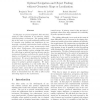Free Online Productivity Tools
i2Speak
i2Symbol
i2OCR
iTex2Img
iWeb2Print
iWeb2Shot
i2Type
iPdf2Split
iPdf2Merge
i2Bopomofo
i2Arabic
i2Style
i2Image
i2PDF
iLatex2Rtf
Sci2ools
ICRA
2003
IEEE
2003
IEEE
Optimal navigation and object finding without geometric maps or localization
In this paper we present a dynamic data structure, useful for robot navigation in an unknown, simplyconnected planar environment. The guiding philosophy in this work is to avoid traditional problems such as complete map building and localization by constructing a minimal representation based entirely on critical events in online sensor measurements made by the robot. Furthermore, this representation provides a sensor-feedback motion strategy that guides the robot along an optimal trajectory between any two environment locations, and allows the search of static targets, even though there is no geometric map of the environment. We present algorithms for building the data structure in an unknown environment, and for using it to perform optimal navigation. We implemented these algorithms on a real mobile robot. Results are presented in which the robot builds the data structure online, and is able to use it without needing a global reference frame. Simulation results are also shown to demo...
Data Structure | ICRA 2003 | Robot | Robot Navigation | Robotics |
| Added | 04 Jul 2010 |
| Updated | 04 Jul 2010 |
| Type | Conference |
| Year | 2003 |
| Where | ICRA |
| Authors | Benjamín Tovar, Steven M. LaValle, Rafael Murrieta-Cid |
Comments (0)

